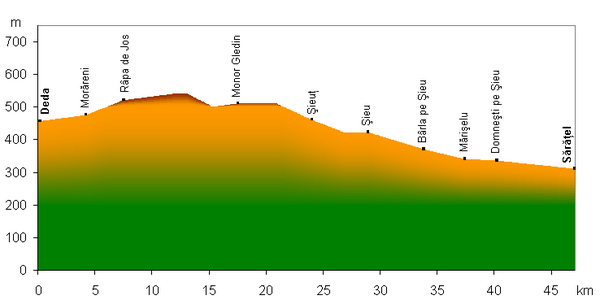Sărățel – Deda railway line
| Sărățel – Deda | |||||||||||||||||||||||||||||||||||||||||||||||||||||||||||||||||||||||||||||||||
|---|---|---|---|---|---|---|---|---|---|---|---|---|---|---|---|---|---|---|---|---|---|---|---|---|---|---|---|---|---|---|---|---|---|---|---|---|---|---|---|---|---|---|---|---|---|---|---|---|---|---|---|---|---|---|---|---|---|---|---|---|---|---|---|---|---|---|---|---|---|---|---|---|---|---|---|---|---|---|---|---|---|
| Course book route (CFR) : | 400 | ||||||||||||||||||||||||||||||||||||||||||||||||||||||||||||||||||||||||||||||||
| Route length: | 47 km | ||||||||||||||||||||||||||||||||||||||||||||||||||||||||||||||||||||||||||||||||
| Gauge : | 1435 mm ( standard gauge ) | ||||||||||||||||||||||||||||||||||||||||||||||||||||||||||||||||||||||||||||||||
|
|||||||||||||||||||||||||||||||||||||||||||||||||||||||||||||||||||||||||||||||||
The Sărățel – Deda railway (Hungarian: Szeretfalva – Déda-vasútvonal) is a main line in Romania . It runs from Mureș to the upper reaches of the Șieu River through the north of the Transylvanian Basin .
history
From around 1870 to 1910, most of the areas of Transylvania , which at that time belonged to the Kingdom of Hungary within the Habsburg dual monarchy , were opened up for railway technology . Since the end of the First World War, larger railway construction projects have only been carried out here in the mountainous regions after belonging to Romania ; one example is the crossing of the Eastern Carpathians between Ilva Mică and Vatra Dornei in 1938.
A completely new situation arose with the Second Vienna Arbitration in 1940, through which Transylvania was divided. Hungary received northern and part of eastern Transylvania , the so-called "Szeklerzipfel". The new border between Romania and Hungary ran over several important railway lines. The railway lines in eastern Transylvania - the Szeklerland with the cities of Târgu Mureș (Hungarian Marosvásárhely ), Sfântu Gheorghe ( Sepsiszentgyörgy ) and Miercurea Ciuc ( Csíkszereda ) - had no connection with the existing routes in northern Transylvania and the rest of Hungary.
Since there was frequent friction between the Hungarian ( MÁV ) and the Romanian ( CFR ) railway companies at the railway border crossings, the Hungarian government decided to close the existing gap to the railway network in Eastern Transylvania. In 1941/42 the construction of the 47 km long route between the places Sărățel ( Szeretfalva ) and Deda ( Déda ) took place. Sărățel was on the route from Dej ( Dés ) to Bistrița ( Beszterce , German Bistritz ) in northern Transylvania, Deda on the connection between Târgu Mureș and Gheorgheni ( Gyergyószentmiklós ).
Even during the Second World War - in which both Hungary and Romania were allies of Germany - the new route gained enormous importance for the German war economy; Romanian oil in particular was transported to Germany on it.
After the end of the war, however, Romania benefited from the construction of the line, as the country received the "Szeklerspitze" back in the Treaty of Paris . The line from Deda to Sărățel became part of an important connection from the south-east to the north-west of Transylvania.
Todays situation
The line is electrified and single-track. Several express trains run daily on it from Brașov to Satu Mare or in the opposite direction. The connection is also still of great importance for freight traffic.
Individual evidence
- ↑ Eugen Kreidler: The railways in the sphere of influence of the Axis powers during the Second World War. Commitment and performance for the Wehrmacht and the war economy (= studies and documents on the history of the Second World War. Vol. 15). Musterschmidt, Göttingen et al. 1975, ISBN 3-7881-1416-9 , p. 88.


